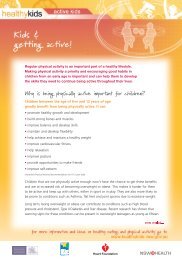I Move We Move - Good For Kids - NSW Government
I Move We Move - Good For Kids - NSW Government
I Move We Move - Good For Kids - NSW Government
Create successful ePaper yourself
Turn your PDF publications into a flip-book with our unique Google optimized e-Paper software.
5.3<br />
Learning fundamental movement skills<br />
The importance of order of acquisition<br />
The development of fundamental movement skills is age-related, however it is not age-dependent.<br />
Additionally the order in which children gain these movement skills is important, not the age they<br />
gain them 22 .<br />
See Active <strong>Move</strong>ment for Under Fives, Series One (babies and toddlers) and<br />
Fun <strong>Move</strong>s for Preschoolers; for video footage of gross motor development and<br />
fundamental movement skills for each developmental period.<br />
There is an order in which each category of skills are developed – stability, locomotor then<br />
manipulative, and there is also an order within each category.<br />
See Figure 5.3, pages 5.11 – 5.19 for the order of skills development within<br />
each category<br />
There are three developmental periods in relation to gross motor development and the development<br />
of fundamental movement skills in young children (birth to five years old). The three developmental<br />
periods are from birth to 12 months, one to three years old and three to five years old. <strong>For</strong> individual<br />
children, these periods should be used as a guide only, as every child develops at a slightly different rate 16 .<br />
As children’s muscles develop from the head downwards and the centre of the chest outwards,<br />
physical activity or movement experiences should follow this development. An example of this in<br />
action for the fundamental movement skill of catching for each developmental period is:<br />
• Baby tracking moving objects (bubbles, rolling ball) with his eyes when lying on his back, side<br />
and front<br />
• Toddler being encouraged to pat and catch a large balloon<br />
• Preschoolers playing catch in pairs across a waist height net using a balloon or light weight ball<br />
“<br />
Throughout our busy daily schedules early childhood<br />
professionals are committed to supporting families and the<br />
children in their care. To achieve this we must be informed.<br />
While services are very familiar with the current philosophy<br />
of Reggio and the 100 languages of children, it may be the<br />
case that we only really know 99 of these langauges well and<br />
need to learn more about the language of physical activity.<br />
”<br />
Jannelle Gallagher<br />
Authorised Supervisor, Kurri Kurri<br />
and District Pre-School Kindergarten<br />
I <strong>Move</strong> <strong>We</strong> <strong>Move</strong>, The Guide Edition 1 August 2009<br />
AREA HEALTH SERVICE




